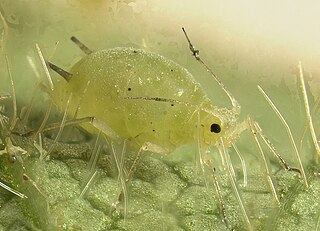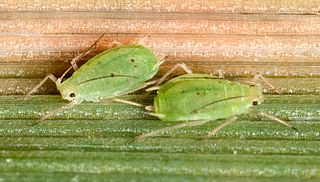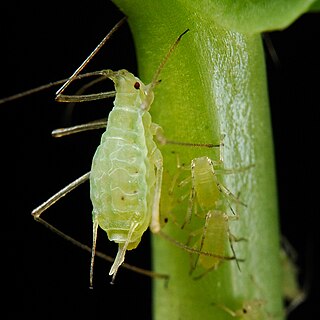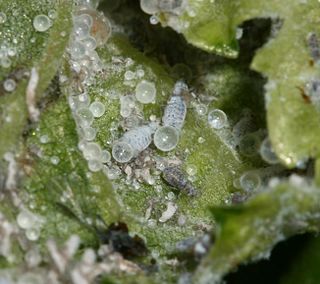
Onoclea sensibilis, the sensitive fern, also known as the bead fern, is a coarse-textured, medium to large-sized deciduous perennial fern. The name comes from its sensitivity to frost, the fronds dying quickly when first touched by it. It is sometimes treated as the only species in Onoclea, but some authors do not consider the genus monotypic.

Rhopalosiphum is a genus of aphid of the family Aphididae that includes 16 species worldwide. Apart from sucking the phloem of host plants and thereby being treated in agriculture as pests, some species are vectors for viral pathogens.

Aphis is a genus of insects in the family Aphididae containing at least 600 species of aphids. It includes many notorious agricultural pests, such as the soybean aphid Aphis glycines. Many species of Aphis, such as A. coreopsidis and A. fabae, are myrmecophiles, forming close associations with ants.

Lipaphis erysimi is a species of aphid of the family Aphididae. Its common names include mustard aphid and turnip aphid. It is found in most temperate and tropical areas of the world and feeds only on cruciferous plants. The insects are almost exclusively female and are very prolific, with wingless females producing around one hundred young during a lifespan of a few weeks.

Megoura viciae is a large, green aphid in the family Aphididae native to Europe that feeds on plants in the genus Vicia. They are commonly known as vetch aphids for this reason.
The Chinese Akkaia,, is an aphid in the superfamily Aphidoidea in the order Hemiptera. It is a true bug and sucks sap from plants.
The Oil Palm Aphid, also known as Schizaphis (Schizaphis) rotundiventris, is an aphid in the superfamily Aphidoidea in the order Hemiptera. It is a true bug and sucks sap from plants.

The greenbug, or wheat aphid, is an aphid in the superfamily Aphidoidea in the order Hemiptera. It is a true bug and feeds on the leaves of Gramineae (grass) family members.
Idiopterus nephrelepidis, commonly known as the black fern aphid, is a species of aphid insect that feeds on various species of fern. It is the type species of the genus Idiopterus.
Sarucallis, also known by its common name as the Crape myrtle aphid or Kirkaldy, is a genus of aphids in the family Aphididae. There is one described species in the genus Sarucallis and it is Sarucallis kahawaluokalanu (S. kahawaluokalani). They can grow to a body length of 1.2 to 1.8 millimeters.
Sitobion luteum, the orchid aphid, is a species of aphid in the family Aphididae. It is found in Europe.

Sitobion is a genus of aphids in the family Aphididae. There are more than 80 described species in Sitobion.
Tuberculatus is a genus of insects belonging to the family Aphididae.

Acyrthosiphon is a genus of aphids belonging to the family Aphididae.

Forda is a genus of aphids belonging to the family Aphididae. The genus was first described by Carl von Heyden in 1837. The species of this genus are found in Eurasia and North America.

Chaitophorus is a genus of aphids first described by Carl Ludwig Koch in 1854. This genus includes roughly 90 to 110 species, and is found in North America, Europe, and Asia.

Eriosoma is a genus of true bugs belonging to the family Aphididae.
Pterocomma is a genus of true bugs belonging to the family Aphididae.
Microlophium is a genus of true bugs belonging to the family Aphididae.

Diuraphis is a genus of true bugs belonging to the family Aphididae.












